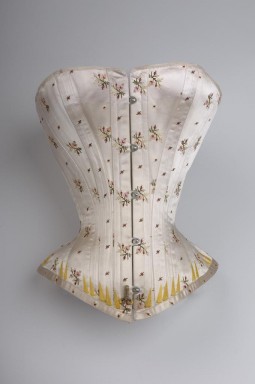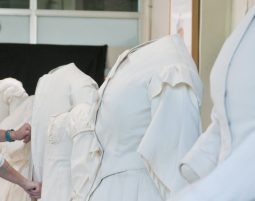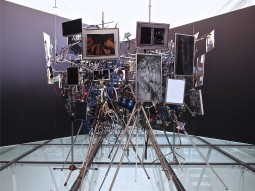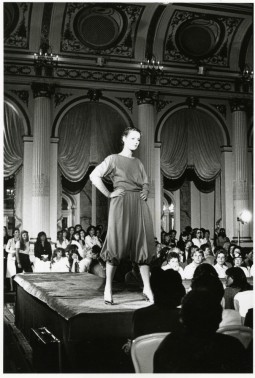Archive for October, 2013
The Europeana Fashion Challenge

Rich as it is, Wikipedia will be enriched some more, specifically with knowledge about shoes and all things fashion. Europeana Fashion is organising three consecutive edit-a-thons this November and presents the first online month-long Europeana Fashion challenge.

Fashion edit-a-thon at Centraal Museum in Utrecht. Photo: Sebastiaan Terburg. Image used under a Creative Commons Attribution license.
After the success of the previous fashion edit-a-thons, organized by European Fashion and a variety of like-minded partners, we’re working on a series of three new edit-a-thons this November.
On the 12th of November Swedish fashion fanatics, Wikipedians and our colleagues from Europeana Awareness will come together at Nordiska Museet in Stockholm to share knowledge and write articles about fashion on Wikipedia. The Nordiska Museet was host to the first edit-a-thon we held and is opening its doors and collections once again. Museum curators provided brand new images of eighteenth century shoes to Wikimedia Commons for your inspiration.
Hosting a stunning collection of shoes is the Italian Europeana Fashion partner Museo Rossimoda della Calzatura in a beautifully located villa outside of Padova. The museum is joining forces with Wikimedia Italy and the Universities of Venice and Padova to teach eighty students what editing on Wikimedia entails and how shoe history can be explained in an open, neutral way on the collaborative encyclopedia. The edit-a-thon at Rossimoda will take place on 14 November. Take a look at the shoes the museum has uploaded onto Wikimedia.
The third edit-a-thon will take place in Israel, where museum specialists from all over the world are coming together at the annual EVA/Minerva conference. Specialists from Wikimedia Israel and Europeana Fashion’s technical coordinator Marco Rendina will present the edit-a-thon series and give an introductory session on how to become a contributor to Wikipedia. A local edit-a-thon event will be held on the 20th of November at the Holon Institute of Technology.
But you do not have to physically present at the edit-a-thons to participate. To get people all over the world to share their knowledge about fashion we are holding an online competition: the Europeana Fashion Challenge. From 12 November until 12 December anybody can join the competition and write Wikipedia articles, either at one of the edit-a-thons or from home.
You will receive points for creating new articles and expanding existing articles that contain one or many Europeana Fashion images. You have a month to gain as many points as possible. The Europeana Fashion Challenge is not only a fun and educational experience, you also have the chance to win some nice prizes. Keep an eye on this page to join the challenge!
Do you want more information or join one of the edit-a-thons?
12 November – Stockholm – at Nordiska Museet (in English)
14 November – Padova – at Museo Rossimoda della Calzatura (in Italian)
20 November – Tel Aviv - at the Design Faculty of the Holon Institute of Technology (a prepatory session will take place on 14 November from 18h00 until 21h00 at the same location)
If you want to find out how to edit on Wikipedia, check out this guide.
By Brigitte Jansen, Sound and Vision
Time will solve the answer to both those questions, best mobile tracker assuming such a controller even existsThe Collection of Wien Museum

The Wien Museum is one of the partners that will submit its collection to the Europeana Fashion portal. The collection is characterised by evening dresses, ball gowns and delicate undergarments from the 19th and 20th century that sketch an image of Vienna and the Viennese society.
The fashion ollection of the Wien Museum was founded after the second world war by Alfred Kunz, the first director of the Vienna Fashion School in Hetzendorf. In 1954, his private collection was combined with the collection of the city of Vienna and became part of the Wien Museum.
Today it is one of the largest European costume collections, comprising over 22.000 objects, mainly women’s dress and accessories such as hats, shoes, handbags, umbrellas, etc., and a small collection of men’s and children’s dress and accessories.
The emphasis lies on women’s fashion of the 19th and 20th century, in particular evening dresses and ball gowns. The collection also comprises fragile ladies underwear from around 1900 and the 1920s, satin shoes and boots from the early 19th century, wedding dresses, “Reform” dresses designed by Kolo Moser, designs from Christoph Drecoll, Ludwig Zwieback, W.F. Adlmüller, Gertrude Höchsmann, Farnhammer, Fashingbauer and millinery creations by Adele List.
The collection is continually growing, through purchases and contributions, in order to document the historical development of fashion and dress typical for Vienna and the Viennese society.
Visit the website of Wien Museum.

"Biedermeier“ dress, 1828, made of a very fine white batist, hand-embroidered and handsewn. Collection Wien Museum.
You Can Look and You Can Touch Too

Fashion is highly visual . Naturally, so are fashion exhibitions, where we can always look, but usually cannot touch. There is good reason not to touch though, garments are highly sensitive and museums do their utmost best to conserve them. But is fashion not more than just the visual and what if you are visually impaired? Our partner Museo del Traje is creating an area where you cannot just look, but also touch.
One of the main goals of Museo del Traje –as of all the national museums of the Spanish Ministry of Education and Culture- is to communicate its collections to the widest possible public.
Nevertheless, garments have to be exhibited in particular conditions as textile is very sensitive to light, air and humidity. Therefore, the museum changes the garments in its permanent exhibition every few years and makes sure that all support materials are acid-free. To make the representation as accurate as possible, the museum also creates its own mannequins, which are made to measure for each historic outfit. They are also shaped and painted in such a way that once the garment is put on the mannequins virtually dissappear.
These conditions might make it difficult for people with perception problems to fully appreciate them though. That is why Museo del Traje is creating a special sensorial area where visitors may touch the garments, to perfectly complement the experience in the permanent exhibition and the educational area. The sensorial area displays mannequins with replicas of the highlights displayed in the permanent exhibition. With an audio tour that develops each garment in full detail, visitors can hear and touch at the same time.
The sensorial area will allow visitors to trace the evolution of male and female garments and changing silhouettes over time. There will also be a “textile library” giving the visitors an overview of fibres and fabrics as well as a chance to experience tools that have been used throughout history for the making of costume.
The sensorial area will be opened in 2014 and will be accessible to all visitors of the museum.
As you can see in the photo below, the game controller wraps around the http://topspyingapps.com device just like other mfi game controllers, and has an option that will allows users to tilt the iphone up
MUDE brings Portuguese fashion design to Tumblr

This month, our partner Museu do Design e da Moda (MUDE) gives an exclusive behind-the-scenes look at the museum’s preparation of its upcoming Felipe Oliveira Baptista exhibition.
The exhibition features the work of Portuguese fashion designer Felipe Oliveira Baptista. Baptista graduated in fashion design from Kingston University in the late 90s and went on to work for established houses, such as MaxMara and Cerruti. He also entered into creative collaborations with Nike and Uniqlo. Along the way his work received wide recognition as he gathered awards from LVMH and the Hyères Festival. Currently, Baptista is the Creative Director of Lacoste and also runs his own label, shown in Paris during the Haute Couture and Ready-To-Wear collections.
Baptista has had his work exhibited several times and will now have a exhibition fully dedicated to his work at MUDE. MUDE will give a sneak preview of the exhibition on our Tumblr by showing how the exhibition is being build up, a process normally not visible to the public. Conceived as an installation, this exhibition offers an immersion into the creative universe of Felipe Oliveira Baptista, escaping from the typical chronologic and linear style of exhibition.
The scenography, designed by Bureau Betak, is a kaleidoscopic space with mirrors intersecting the gallery in different angles and directions. It offers a multifaceted reading of Baptista’s journey and work, from the time when he has was recognized with the Grand Prix at the Festival d’Hyères (2002) until now. The result is not just an exhibition, but a place that plays with reality and fiction, with the object and its image, thereby capturing the scenic, performative and always transforming universe of fashion.
The exhibition opens on 17 October 2013, but you can already get a sneak preview on our Tumblr.Lastly, they are delivering free webinars and have archived many that have already been delivered, so if you’re interested in learning more about their findings and recommendations, you write my essays Main can do so right from your desk
Europeana Fashion at the LIM College Conference in New York this Friday

Friday, October 4, LIM College will host Alessandra Arezzi Boza, Communications Director of the Europeana Fashion Project, to the conference “Fashion: Now & Then: Meaning, Media, and Mode” to discuss the past, present, and future uses of global fashion information.
LIM College will host Fashion: Now & Then: Meaning, Media, and Mode, a conference in which participants will discuss the past, present, and future uses of global fashion information, Thursday, October 3 through Saturday, October 5, 2013 at LIM College (12 East 53rd Street).
This year’s edition of the annual international fashion information conference will feature the exclusive preview of Europeana Fashion, the online European fashion archive connected to Europeana, the European Digital Library.
Alessandra Arezzi Boza, Communications Director of the Europeana Fashion Project, will hold her speech on Friday, October 4 from 10:15-11:00 a.m.
The presentation talks about Europeana Fashion as a best practice network composed of 22 partners from 12 European countries, which represent the leading European institutions and collections in the fashion domain. It focuses on the first year basis results achieved in all Project related activities, with a huge quote of its successful communication strategy. In this occasion a preview of the website and a presentation of its functionalities and features will be showed for the first time.
“Europeana Fashion offers a variety of specialized services and features including a specialized data model known as EDM-fp, a fashion thesaurus available in 10 languages, and the IPR Best Practice Guidelines Manual, which was created in collaboration with the V&A to assist Europeana Fashion partners in clearing intellectual property rights for images. In addition to delivering content through its portal, Europeana Fashion will develop an interactive component — with a Tumblr blog dedicated to virtual fashion exhibitions curated by partners and guest curators, an events section, and an active presence on leading social media platforms. Europeana Fashion aims to become a true forum of fashion, where all of its users and communities—including the general public, creative and research professionals, and fashion institutions– exchange information on fashion topics, contribute fashion content and provide feedback.
Lisa Ryan, LIM College Reference & Instruction Librarian and organizer of the Fashion: Now & Then conference said, “We are very pleased the Europeana Fashion consortium has chosen to announce their worldwide preview at our conference. Until Fashion Now & Then began in 2011, there had not been an international forum for discussion among fashion information professionals. Unfortunately, a significant portion of historical fashion and fashion-related information and materials have been lost or not collected and preserved, and information about their existence and availability has not been well-disseminated. LIM College is very proud to be the venue of choice for the introduction to the world of what will be the premier source of European digital fashion information.”
For more information please visit:
LIM College
Fashion: Now & Then
Instructors at my school have often asked if there was an easy way they could turn off internet access on the computers pay for homework for https://homework-writer.com/ in our computer lab classrooms













